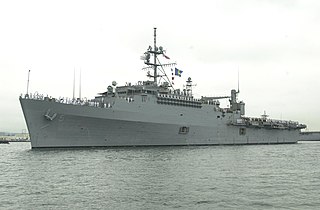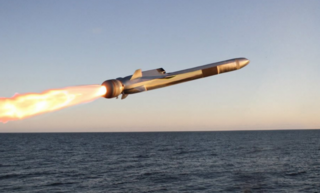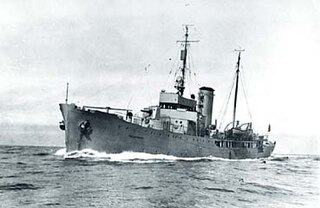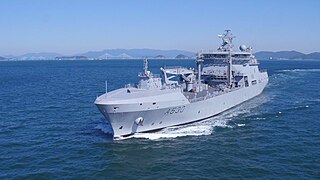
The Royal Norwegian Navy is the branch of the Norwegian Armed Forces responsible for naval operations of Norway, including those of the Norwegian Coast Guard. As of 2008, the Royal Norwegian Navy consists of approximately 3,700 personnel and 70 vessels, including 4 heavy frigates, 6 submarines, 14 patrol boats, 4 minesweepers, 4 minehunters, 1 mine detection vessel, 4 support vessels and 2 training vessels.

USS Ogden (LPD-5), an Austin-class amphibious transport dock, was the second ship of the United States Navy to be named for Ogden, Utah. Ogden was laid down on 4 February 1963 by the New York Naval Shipyard. She was launched on 27 June 1964 sponsored by Mrs. Laurence J. Burton, and commissioned at New York City on 19 June 1965.
Fridtjof Nansen (1861–1930) was a Norwegian polar explorer, scientist, diplomat, humanitarian, and Nobel laureate.

Otto Neumann Knoph Sverdrup was a Norwegian sailor and Arctic explorer.

The Fridtjof Nansen-class frigates are a class of frigates that are the main surface combatant units of the Royal Norwegian Navy. The ships are named after famous Norwegian explorers, with the lead ship of the class bearing the name of Fridtjof Nansen. Five ships were ordered from Spanish shipbuilder Bazan.

The Álvaro de Bazán class, also known as the F100 class, is a class of Aegis combat system-equipped air defence frigates in service with the Spanish Navy. The vessels were built by Spanish shipbuilder Navantia in Ferrol, with the lead ship of the class named for Admiral Álvaro de Bazán.

The Oslo-class frigate is a Royal Norwegian Navy frigate design of the 1960s, based on the US Navy Dealey-class destroyer escorts. The forward hull was customized to suit Norwegian sea conditions better and several sub-systems were European built. Ships of the class operated until 2007, when they were replaced by the Fridtjof Nansen class.

HNoMS Fridtjof Nansen is a frigate of the Royal Norwegian Navy. Launched on 5 April 2006, she is the lead ship of the Fridtjof Nansen class of warships.

Marinejegerkommandoen (MJK) is the maritime/naval special warfare unit of the Norwegian Armed Forces and was established in 1953.

HNoMS Roald Amundsen is a Fridtjof Nansen-class frigate of the Royal Norwegian Navy.

HNoMS Helge Ingstad was a Fridtjof Nansen-class frigate of the Royal Norwegian Navy. The vessel was ordered on 23 June 2000 and constructed by Navantia in Spain. The ship was launched on 23 November 2007 and commissioned on 29 November 2009. Named for Helge Ingstad, a Norwegian explorer, the Fridtjof Nansen class are capable of anti-air, anti-submarine and surface warfare. On 8 November 2018, HNoMS Helge Ingstad was in a collision with the tanker Sola TS in Norwegian waters just outside Sture Terminal. Helge Ingstad was severely damaged in the collision and ran aground. On 13 November 2018, the ship sank where she had run aground and became a constructive total loss.

HNoMS Thor Heyerdahl is a Fridtjof Nansen-class frigate of the Royal Norwegian Navy.

The Naval Strike Missile (NSM) is an anti-ship and land-attack missile developed by the Norwegian company Kongsberg Defence & Aerospace (KDA).

Fridtjof Nansen was the first ship in the Norwegian armed forces to be built specially to perform coast guard and fishery protection duties in the Arctic. She saw service in the Second World War with the Royal Norwegian Navy until she ran aground on an unmarked shallow at Jan Mayen in November 1940.
There have been several ships in the Royal Norwegian Navy named after the Norwegian explorer and Nobel peace prize winner Fridtjof Nansen.
Fridtjof Nansen (1861-1930) was a Norwegian explorer, scientist, diplomat, humanitarian and Nobel laureate.

Nansenflua is an undersea rock in the northern part of Rekvedbukta off the southeastern coast of Jan Mayen in the Arctic Ocean. The shoal is named after the ship HNoMS Fridtjof Nansen, which sank after striking the previously uncharted rock in November 1940. Nansenflua is the only obstruction in Rekvedbukta. The name Nansenflua was introduced in charts published by the Norwegian Polar Institute in 1955, and is included as a recognized name in Anders K. Orvin's 1960 paper The place-names of Jan Mayen. It follows a convention based on two then in force Orders in Council, dated 28 April 1933 and 31 May 1957, of using the Nynorsk grammatical form. The suffix "-a" in the feminine definite form was chosen, as no local dialect existed on Jan Mayen. The last part of the name, "flu(a)", means "rock awash", or "sunken rock". The geographical location is given by Orvin as 70°57′N08°28′W, with an exactitude of 1'. The rock, located two meters under the surface, has a small top area and vertical sides of about twenty meters. It is located about one nautical mile from Eggøykalven and 1.7 nautical miles west-southwest of the peninsula Eggøya. In anything but completely calm weather conditions, Nansenflua is visible by waves being broken against it. The rock is part of the remains of a crater.

HNoMS Maud is a replenishment oiler constructed at Daewoo Shipbuilding & Marine Engineering in South Korea. She was built on behalf of the Norwegian Defense Materials Agency Forsvarsmateriell, for service in the Royal Norwegian Navy.
















